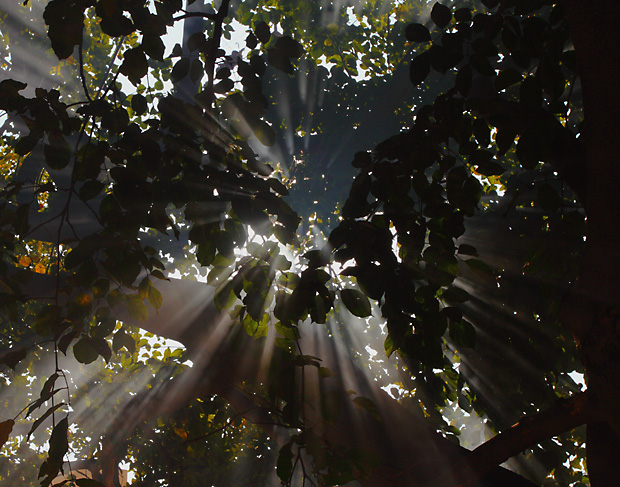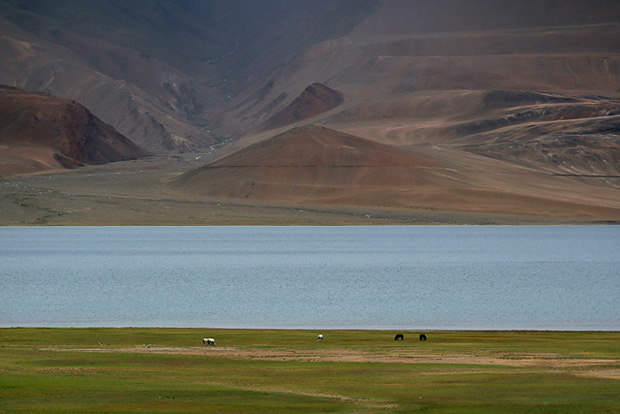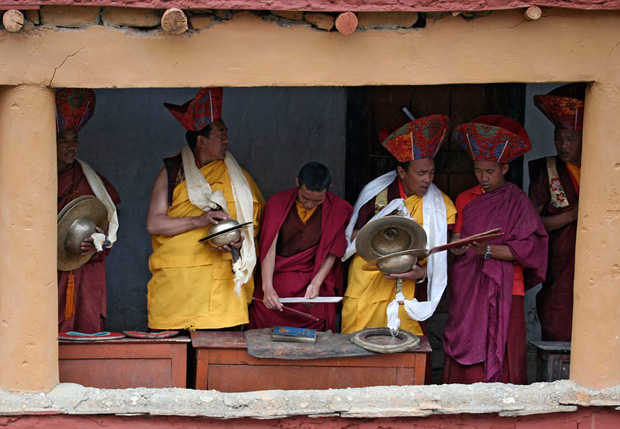There are largely three kind of people you get to see in Leh. The Ladakhi Buddhists are the one you encounter most often – they are the native inhabitants and manage most of the tourist infrastructure in the region. The next set of people you see very often are the tourists. They probably outnumber locals in summer and vanish during the cold winter season. The third biggest population is of Kashmiris who come from Srinagar and surrounding areas in Kashmir Valley. They mostly work as labourers doing all the hard job that locals would prefer to outsource. You often see them pushing carts with large drums of water to hotels and restaurants in the water-starved Leh. Their population appears small going by the number of people you see on the streets, but they perhaps stay behind the scene and do all the tough jobs. The only time you see them in large numbers is during the morning prayers at the mosque in the main market.
I had a short conversation with one such Kashmiri when I was walking towards Leh’s new bus stand. It is a long walk on a winding road from main market to bus stand. When I saw a small lane that appeared to be a short-cut, I stopped to check with someone if the alley takes me to bus-stand.
“Yes,” he told me, “I am headed that way too. Come, let’s walk together.”
This man had a tall build with a reddish face, sunken cheeks and a long curvy nose—features typical of Kashmiri men. For a moment I wondered if it is a Kashmiri way to invite people to walk together. A few days ago when I was looking for directions to Shanti Stupa, a little girl who happened to be from Kargil had asked me to walk with her.
We walked together to the bus-stand that was just five minutes away at the other end of the alley.
Our conversation started with the usual question – ‘where are you from?’ I answered him and asked him the same question.
‘From Kupwara district,’ he replied, ‘are you travelling?’
I nodded in affirmative.
‘Have you been to Srinagar too?’
I silently shook my head in response. I had entered Ladakh through Manali – Leh highway and had never visited Srinagar before.
‘What is there in Leh that you want to come here?’ he continued talking now a bit excitedly, ‘Go to Srinagar, it is green and beautiful. There is nothing to see here – the mountains are arid and there isn’t even enough air to breathe. It is tiring to walk up and down these roads. We end up breathless. You must see Srinagar.’
He was spending the summer in Leh and did not seem to like it here. It is also perhaps natural that he loved the place he can associate better with.
In fact, on our way to Leh, we were contemplating taking the Srinagar – Leh highway and spend some time in Kashmir Valley to visit Gulmarg and Dal Lake. The militancy from across the border had come down in the recent years and it seemed safe to visit Srinagar. But in the days of calm and absence of external threat, the residents had made the valley unapproachable just when we were planning our journey. Violence had broken out in Kashmir a few days before our departure over ownership of 40 hectares of land in Amarnath, cutting off supplies and blocking the roads to the valley. It was no longer possible to go via Srinagar. I had no heart to tell him all this, and silently acknowledged him as we parted.
We had kept our hopes of visiting Srinagar alive, as we could still return from Ladakh via Srinagar. But violence lasted so long that Srinagar was unapproachable even after two months of our stay in Ladakh. As we read through newspapers during the days before our departure, the valley was still boiling over the issue and Srinagar had remained unapproachable. It pains me even today that I could not make it to Srinagar despite having come so close to it. Dal Lake and Gulmarg are two places I have been wanting to visit for many years and had hoped to make it there during the Ladakh trip.
I do not know who is right or who is wrong in the Amarnath land controversy, but nothing really justifies the violence that erupted after the land transfer. A lot of people in Kashmir depend on tourists for their livelihood. The people of Kashmir would be much better off understanding that violence does no good to themselves as well as the visitors, but maintaining peace is beneficial for everyone in the longer run. Perhaps this man who did not like to work in Leh could have found a better job in the tourism industry closer to home, had things been peaceful in Srinagar.
When summer arrives and the trees start shedding leaves, BBMP workers take short cuts and burn the leaves instead of clearing them. One morning when I was walking outside the house, someone had just gathered a few leaves and set them on fire. The resulting smoke created these shafts of light. I had enough time to get back home and bring the camera.

I have written all good things about people of Ladakh in my earlier posts in this series. Ladakhis are usually very warm and cheerful people and always carry an infectious smile (Read: Ladakh – Good Samaritans and Ladakh – Cheerful People). But in my two months of wandering in the mountain country, not every experience was good.
While in Ladakh, we had made an attempt to travel by public transport as much as possible. But there were a few exceptions, like the time we hired a bike to get to Pangong Lake to ensure that we could stop and go as we wished, or when we took a cab to get us to Tso Moriri Lake in time for a festival. The cab dropped us at Korzok Village on the bank of the lake and returned to Leh. Knowing that the date of arrival of next bus is still many days away (read about public transport in Ladakh, where I talk about buses to some places being available at an interval of every 10 days), we scouted for options to get back to Leh.

Tso Moriri Lake
Our initial plan was to look for seats to share in a returning cab or even a small truck. Since this was festival time, the inflow of tourists was higher than normal and there was a good chance to find taxis returning to Leh with some seats empty. After looking around at all the hangouts in the village, we found a group of four Israelis willing to take us back with them to Leh. These people had taken a cab from Leh to Tso Moriri and were planning to get back to town next morning, stopping for a night at Tso Kar. It suited us well. We had not planned a visit to Tso Kar earlier, but it would be good to get a glimpse of the lake, even if it is for just one evening. Although it was not necessary, we informed their driver Tashi that we would be joining the group on the next part of the journey. In a semi-inebriated condition that evening, Tashi smiled and nodded cheerfully.

Celebrations – Korzok Gustor Festival on the banks on Tso Moriri
The next morning, we packed our bags and waited to hear from the group of Israelis when they are ready. At about 11am, one of them walked into our guest house to deliver a bad news – ‘Tashi is refusing to take you two in the cab!’ For a moment we were worried. Because we had managed to get transport yesterday, we did not bother to look further. It meant getting stranded in Korzok for at least a day, or more if there is no transport available even on the next day.
What ensued was a long argument between Tashi and us. His case was that the cab, a Tata Sumo, would not be able to pull a load of additional people in the mountain roads. It did not seem to make sense. Drivers take 10 passengers along the Manali – Leh highway in Tata Sumos every day, while here it would be just six people including us today. And if he did not want to take us, he should have refused yesterday evening when we volunteered to inform him about us joining the group. After a short exchange of words with Tashi that actually left us struggling to breathe in Tso Moriri’s this air, Tashi suddenly obliged but refused to talk to us any more.
Later in the evening when we reached Tso Kar, Tashi reminded of us struggling to accelerate in a steep slope on the way where he had to ask all of us to get out and walk a short distance. Tashi had attempted to go off road and take a steep short cut, but the cab had refused to go further. He recalled the incident in support of his argument in the morning. Now in a better mood, he also said he was very upset because we had raised our voices in Tso Moriri.
That morning, we had tried to keep a calm and worked hard to keep our voices low even when we expressed unhappiness with Tashi and argued that he can’t refuse to take us. But having walked briskly to his cab and blabbering a few sentences breathless, talking further was a struggle and we might have sounded discourteous as we spoke with difficulty, almost chokingly. I explained it to Tashi and apologized if we had sounded rude. In a region where people are so friendly that anyone getting angry is almost unimaginable, we might have sounded as if we had crossed some limits.
We finally made amends with Tashi, who opened up a bit after this conversation in Tso Kar. But it still remains a puzzle why he agreed to take us in the first place and refused later. Perhaps it was the effect of whiskey, which kept him in a generous mood when we spoke to him first!
About two weeks after we left Tso Moriri, we were to have some more uncomfortable experiences (link to a really long post on a trek in Zanskar, part of which are some unhappy experiences) while trekking in the heart of Zanskar.


